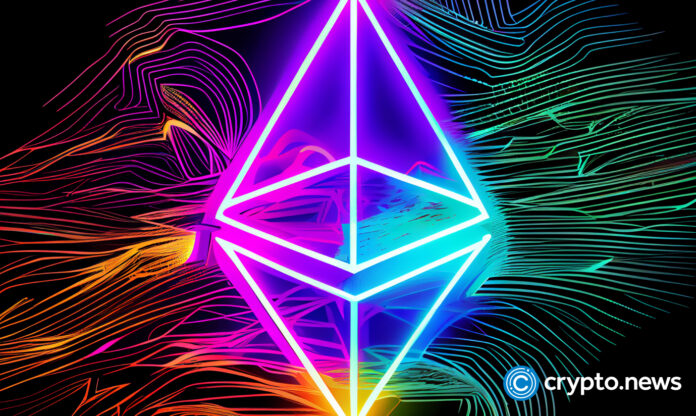Despite its relatively recent launch, Ethscriptions has shown tremendous acceptance, evoking parallels with Bitcoin’s Ordinals.
The Ethereum (ETH) community, known for its unrelenting pursuit of experimentation and innovation, has a new brainchild—Ethscriptions.
Ethscriptions is the latest protocol stirring interest in the Ethereum community. It leverages Ethereum’s calldata to enable users to inscribe non-financial data directly onto the Ethereum main chain.
Developed by Tom Lehman, co-founder of Genius.com, Ethscriptions offers a more decentralized and economical approach than the conventional contract storage method.
By leveraging Ethereum’s calldata, Ethscriptions allows users to inscribe non-financial data under 96 kilobytes in size, primarily images at present, directly onto the Ethereum main chain.
It’s the literary equivalent of etching a message in stone—a message that will remain etched in the vast digital landscape of Ethereum.
With an overwhelming response from the community, close to 30,000 Ethscriptions were created within 18 hours of the protocol’s launch. This dynamic debut echoes the launch of Ordinals on Bitcoin, marking another pivotal moment in the blockchain world.
Ethscriptions vs. Ordinals: a tale of two protocols
Bitcoin’s (BTC) Ordinals and Ethereum’s Ethscriptions were born from a shared vision: to expand blockchain beyond mere financial transactions.
While Ordinals marked the Bitcoin network’s foray into the world of non-financial data inscriptions, Ethscriptions, albeit similar, bring a fresh perspective to the Ethereum network.
While both protocols reflect innovation, the community’s response is a stark difference. The introduction of Ordinals faced pushback from some Bitcoin maximalists, resistant to deviating from Bitcoin’s primary function as a financial asset.
On the other hand, the Ethereum community embraced Ethscriptions with open arms. Ethereum’s culture of innovation and experimentation could explain this acceptance, as it has always positioned itself as a ‘world computer’ and a platform for decentralized applications (dApps) rather than just a currency.
Ordinals and Ethscriptions use different methods to inscribe data. Ordinals rely on Bitcoin’s transaction data, whereas Ethscriptions leverages Ethereum’s “calldata.”
Ethereum’s approach is seen as more decentralized and cost-effective than using contract storage, a significant point of difference.
Ordinals allow various inscriptions, including artwork, profile pictures, and playable games. Ethscriptions, although currently limited to image-only inscriptions, intends to expand to accommodate different file types, potentially leading to broader applications.
A notable implication of both protocols is the potential rise in transaction costs. Bitcoin saw an increase in transaction fees with the advent of Ordinals, a likely scenario for Ethereum with Ethscriptions, especially given Ethereum’s already high transaction fees.
The community response and potential implications
An undeniable indicator of the community’s excitement about this groundbreaking venture is the launch of Ethereum Punks, a collection of non-contract punks similar to those on the Bitcoin network. All 10,000 inscriptions were claimed almost immediately post-launch.
However, this high activity level resulted in occasional downtime and necessitated Lehman’s assurances to the community about the project’s technical stability.
Ethereum’s innovation doesn’t come without implications. The launch of Ethscriptions could result in an upswing in Ethereum’s transaction fees.
But do not let this dissuade you. Increased transaction fees incentivize miners to sustain their efforts, ultimately fortifying the security of the decentralized platforms.
This measure is crucial, considering Ethereum tops the chart as the most expensive chain for transactions and development.
Future of Ethscriptions
The narrative of Ethscriptions may have just begun, but its potential ramifications are colossal. Users can only inscribe images, but Lehman hints at a future where different file types could be uploaded.
The widespread acceptance of Ethscriptions illuminates the continued push for innovation and the endless quest for improved functionalities within the blockchain universe.
While some argue that similar technologies have existed for years, Ethscriptions’ swift adoption and awareness underline a newfound appreciation for such initiatives.
Whether Ethscriptions will continue to make waves or become a transient ripple in the blockchain pond depends on the ongoing community engagement and adoption.
For now, Ethereum’s innovative spirit remains undeterred, continuously seeking new territories to explore in the expansive universe of blockchain.
Credit: Source link






















 Bitcoin
Bitcoin  Ethereum
Ethereum  Tether
Tether  Solana
Solana  USDC
USDC  Lido Staked Ether
Lido Staked Ether  XRP
XRP  Dogecoin
Dogecoin  Toncoin
Toncoin  Cardano
Cardano  Shiba Inu
Shiba Inu  Avalanche
Avalanche  TRON
TRON  Wrapped Bitcoin
Wrapped Bitcoin  Polkadot
Polkadot  Bitcoin Cash
Bitcoin Cash  Chainlink
Chainlink  NEAR Protocol
NEAR Protocol  Polygon
Polygon  Internet Computer
Internet Computer  Fetch.ai
Fetch.ai  Litecoin
Litecoin  Uniswap
Uniswap  Dai
Dai  LEO Token
LEO Token  Ethereum Classic
Ethereum Classic  Hedera
Hedera  Aptos
Aptos  Render
Render  First Digital USD
First Digital USD  Pepe
Pepe  Cosmos Hub
Cosmos Hub  Cronos
Cronos  Mantle
Mantle  Stacks
Stacks  Filecoin
Filecoin  Immutable
Immutable  dogwifhat
dogwifhat  Stellar
Stellar  Wrapped eETH
Wrapped eETH  XT.com
XT.com  Renzo Restaked ETH
Renzo Restaked ETH  Bittensor
Bittensor  OKB
OKB  Optimism
Optimism  Arbitrum
Arbitrum  The Graph
The Graph  Maker
Maker 
